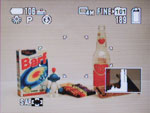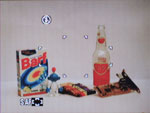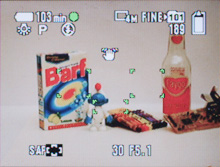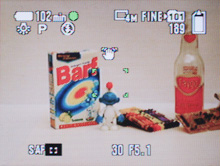DSC-L1: Sony's Latest Ultra-Compact Digicam
by Stephen Caston on January 27, 2005 12:05 AM EST- Posted in
- Digital Camera
Recording Features
In all recording modes except Auto, the DSC-L1 records images as JPEG files with quality settings: Fine or Standard. In Auto mode, the camera always uses the Fine setting. The resolution options are below:| Setting | Resolution (pixels) |
| 4M | 2304x1728 |
| 3:2 | 2304x1536 |
| 3M | 2048x1536 |
| 1M | 1280x960 |
| VGA | 640x480 |
The L1 offers 9 different recording modes: Auto, Program, Twilight, Twilight portrait, Landscape, Soft snap, Snow, Beach, and Candle. In Auto mode, the camera will determine all the advanced settings for you, so all you have to do is point and shoot. However, there are still some key operation functions that are available. For example, the multi-directional controller can be used to select from the following flash modes: Auto, Forced flash, Slow synchro, and Off. Forced flash is an option that allows you to force the flash to fire, even if it is not needed for adequate light. This option is frequently used to fill in the shadows on a person's face or to illuminate a backlit subject. Slow synchro is a two-part flash mode that utilizes a slower shutter speed. The camera uses a long exposure during which the flash fires and the shutter stays open to gather ambient light to capture background detail. The result is a picture with a well-lit foreground and background as opposed to a picture where the background is dark. By pressing down on the controller, a 10-second self-timer can be enabled. By pressing the Image quality button, a resolution setting can be selected from the options listed in the table above. Pressing the Menu button will bring up a menu with the following record modes: Normal, Burst, and Multi Burst. In Burst mode, the camera can take pictures continuously while the shutter button is held down. The maximum number of pictures is determined by the resolution and quality settings. At resolution setting "4M" and quality setting "Fine", the L1 can record up to 4 images in a row. With Multi Burst, the camera will record 16 images each time that the shutter button is pressed. These images are assembled into a 1280x960 JPEG and recorded to the flash card. In Auto mode, the interval between each picture is set to 1/30th sec. However, in all other recording modes except the Twilight and Landscape modes, there are options for 1/15th and 1/7.5th sec. as well. When these Multi Burst pictures are reviewed in-camera, each picture is displayed full screen in an animation. The DSC-L1 does not have a designated macro mode. Instead, at any time, it is capable of focusing on objects as close as 4.7".
 |
 |
 |
By pressing the Display button, the camera will toggle through four different displays: normal, normal w/live histogram, less information, backlight off. The option to turn off the backlight is an interesting idea. We found that when shooting outdoors, we could not even tell the difference between the on and off states. This leaves the user a real opportunity to save battery power in brightly-lit situations. It is refreshing to see that the battery status indicator actually provides the number of minutes remaining in the battery charge. Most cameras simply have a two- or three-bar indicator, which leaves you guessing about the exact battery life remaining.
To switch to another mode, simply press the Menu button and select the desired shooting mode under the camera heading. In Program mode, there are several additional options that can be manipulated. For example, by entering the menu, the following options can be adjusted:
| Menu | |
| EV | +/- 2 stops in 1/3 stop increments |
| Focus | Multi AF, Center AF |
| White Bal | Auto, Daylight, Cloudy, Fluorescent, Incandescent |
| ISO | Auto, 100, 200, 400 |
| P. Quality | Standard, Fine |
| REC mode | Normal, Burst, Multi Burst |
| Interval | 1/30, 1/15, 1/7.5 |
| Flash Level | -, Normal, + |
| P. Effect | Off, Sepia, B&W |
| Saturation | -, Normal, + |
| Contrast | -, Normal, + |
| Sharpness | -, Normal, + |
| Setup | Enter |
 Multi AF, Focus lock |
 Center AF, Focus lock |
The auto focus area can be selected from either Multi AF or Center AF. If Multi-AF is selected, the camera will select one or more of 5 possible focus points automatically. The chosen points will be marked as green brackets. If all points are used, the green brackets will not be displayed. For adjustment of the flash level, saturation, contrast, and sharpness, there are 3 levels from which to choose: "-", Normal, or "+". Setup mode is available in all shooting modes, so we will discuss those options a bit later.
In Twilight mode, the L1 can expose scenes for as long as 2 seconds. In Twilight Portrait mode, the camera uses a slow synchro flash to capture both subject and background detail. In Landscape mode, the camera focuses to infinity. In Soft Snap mode, the camera uses less sharpening and saturates colors for warmer tones. In snow and beach modes, the camera applies a positive exposure compensation to ensure bright images. With Beach mode, the camera also ensures that blue tones from water are captured properly. In Candle mode, the L1 uses a slow shutter speed and daylight white balance to capture natural looking candlelit images.
The DSC-L1 records video clips as MPEG files at either 16 or 30 fps with audio. The resolution options are either 640x480 or 160x120. In the 640x480 mode, you can select between Fine (30 fps) and Standard (16 fps). When Fine is selected, a Memory Stick Duo Pro must be used in order to keep up with the data stream. If a regular Memory Stick Duo is used, the Standard option must be selected. With all recording options, the duration of a movie clip is limited only by the remaining space on the flash card.
By pressing the Menu button, there are several additional options that can be adjusted:
| Movie Menu | |
| EV | +/- 2 stops in 1/3 stop increments |
| Focus | Multi AF, Center AF |
| White Balance | Auto, Daylight, Cloudy, Fluorescent, Incandescent |
| P. Effect | Off, Sepia, Black&White |
| Setup | Enter |
Although the optical and digital zoom cannot be adjusted while recording, the camera will focus continuously as it records. In all modes, the 5 setup menus are available as the last option in the main menu. Below, we have outlined the menus:
| Camera 1 | |
| AF mode | Single, Monitor |
| Digital Zoom | Smart, Precision, Off |
| Date/Time | Date/Time, Date, Off |
| Red Eye Reduction | On, Off |
| AF Illuminator | Auto, Off |
| Auto Review | On, Off |
The AF mode option allows you to specify either Monitor or Single. With Single selected, the camera will only focus when the shutter button is pressed halfway down. Then, it will lock focus until you press the shutter button down fully. If Monitor is selected as the AF mode, the camera will focus continuously until the shutter button is half-pressed. Then, it will lock focus until the shutter button is fully pressed. If Red Eye Reduction is enabled, the camera will fire a series of short flashes before taking the picture. This helps to contract the pupils of your subject and reduce the red-eye effect. With Auto Review enabled, the camera will display a 2-second review of an image immediately after it is taken.
| Camera 2 | |
| Enlarged Icon | On, Off |
The Enlarged Icon option refers to the size of icons on the display screen while they are being adjusted. For example, with this option enabled, a larger icon of the flash mode will appear while cycling through different flash options. After about a second, the icon will shrink back down to its normal size. This option simply helps you to see settings as you change them.
| Memory Stick Tool | |
| Format | OK, Cancel |
| Create REC Folder | OK, Cancel |
| Change REC Folder | OK, Cancel |
If Format is selected, the camera will erase all data from the flash card, including files marked as protected. By selecting Create REC Folder, the camera will make a new folder on the flash card. With the Change REC Folder option, you can specify which folder to use to record and review images.
| Setup 1 | |
| LCD Backlight | Bright, Normal |
| Beep | Shutter, On, Off |
| Language | Select |
The DSC-L1 offers two levels of brightness for the LCD backlight. With Shutter selected as a Beep option, the camera will make a "shutter-like" sound when taking a picture. If On is selected, it will make a beeping sound every time when a button is pressed.
| Setup 2 | |
| File Number | Series, Reset |
| USB Connect | PictBridge, PTP, Normal |
| Clock Set | OK, Cancel |
The File Number option allows you to specify how new files are named. If Series is selected, the camera will assign file names incrementally, even if you are in a new folder. If Reset is selected, the camera will start from 0001 each time you change to a new folder. If there are already files in a folder, the camera will start with the next number in that folder. If PictBridge is selected from the USB Connect options, the camera can be connected to a PictBridge-compatible printer. If PTP is selected, when the camera is connected to a computer running Windows XP or Mac OS X, the computer will display a file transfer wizard to assist in copying the files. The "Normal" option allows you to establish a standard USB connection between the camera and a computer.










7 Comments
View All Comments
ksherman - Sunday, January 30, 2005 - link
BTW #6-- to get to contact information, click on 'about' on the left hadn menu (second down) and then click on 'contactAnandtech'Xmate - Saturday, January 29, 2005 - link
Good review, camera seems weak to me (being a photographer) but for a digicam its good, and a good review of it.I notice that Anandtech has taken a liking to digital photography, having several reviews and essays on how to take better photographs and what to take them with. This is all very good. I am really happy that more people are getting involved into the world of photography.
What I ask of Anandtech now, is to continue on their photography reviews, but to add some computer software preformance reviews. I am in the market for a new computer, and i am completely torn as to what CPU, motherboard, ram, graphics card HD to get. I will be using almost exclusively Adobe products on the computer (photoshop, illustrator, Golive Indesign, The whole Creative suite). I'd GREATLY aoreicate if Anandtech could have some benchmarkings of how different Hardware preforms in photoshop and more importantly their ram converter.
Also, I ask that you could perhaps have some reviews of colour calibration devices, such as the Gretagmacbeth ones (www.gretagmacbeth.com) and also if you could tell us what monitors are the best to use for the most acurate colour rendition.
It's great that you have more photographers articles, but people like me (you'd be surprised how many of us visit this site) really need advice on what PC hardware to get for the best and faster results, from cpu to graphics card to monitor to printer. I hope you take this into consideration.
Stefan
PS: I was looking for the 'Contact Us' for Anandtech, but I was unable to find it. If someone could tell me how to contact them directly then I'd greatly apreciate it. Thank you once again.
melgross - Friday, January 28, 2005 - link
As far as I am concerned, all of the test pictures are unacceptable. The outdoor pics aren't bad, though there are better images from others cameras in this price range.The indoor pics are all underexposed badly, and the flash calibration esp. at close distances is very poor.
segagenesis - Thursday, January 27, 2005 - link
Better and less than half the price of my old (4 years old?) DSC-P1. Guess it shows how quickly cameras are evolving.There will always be some edge distortion in smaller cameras, so when buying one this is a given. The lens is just too damn small!
stephencaston - Thursday, January 27, 2005 - link
#1 thanks, its corrected nowarfan - Thursday, January 27, 2005 - link
Maybe it will be better if there is review for all digital camera from entry level until high-end. What about Canon A75 compare with this Sony ?cosmotic - Thursday, January 27, 2005 - link
Are you sure you meant that the release date was Feb 2004?